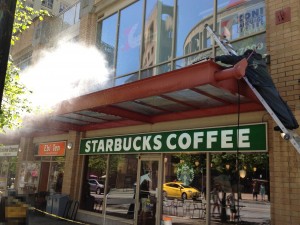What you don’t know you’re not getting could cost you.
Like some cultures who pass their history down to the new generation through tribal elders by way of sharing their experiences, so to is the profession & culture of window cleaning moved forward through a system of mentorship. With no official textbooks, professional guidelines or testing, the success of a new window cleaner is largely affected by the expanse of knowledge (or limits) of his mentor.
If you’ve read our previous article The History of Window Cleaning you’ll be familiar that our industry’s existence is deeply rooted in a tradition of problem solving and ingenuity. A natural prerequisite for our industry, old-fashioned common sense is a great tool to have in one’s kit, however common sense varies greatly from one person to another, and when dealing with important issues such as worker & public safety, common sense should not be solely relied on in the absence of a well thought out site plan.
Window/property cleaning isn’t a ticketed trade, there are few unions, none of which are in Canada, and no regulating bodies to affirm one’s knowledge outside of rope access training. Additionally, WorksafeBC provides certain Occupational Health and Safety Guidelines, but again does not address “How” to perform the work, so again it seems we’re back to “common sense”.
Consider the following two examples of a worksite in action.
A. (Not Imagine Maintenance)
 What is going on in this photo?
What is going on in this photo?
It is about 1:30 in the afternoon on a busy downtown street corner. There are two workers, cleaning BOTH sides of the canopy. The second worker is standing on the foot of the ladder so the ladder doesn’t slip. The only store entrance is blocked off with caution tape, and there are many people inside the store who cannot get out, or customers who cannot get in.
The pressure washer which is leaking profusely is set up on the opposite side of the caution tape creating a choke point for all sidewalk traffic; people with strollers, wheelchairs, etc, and the hose is in a big pile creating a further hazard. Now that the stage is set, lets breakdown the actual work in progress.
1. Time of day – Even without a coffee shop, street corners are busy areas downtown. Pressure washing is unsuitable this late in the day due to increased pedestrian traffic and can negatively impact merchant operations.
2. Fall hazard – Worker is standing on a ladder that is not on a 4:1 safety ratio and is concerned about standing too high and the ladder slipping out underneath him, thus not only working at an inefficient angle for the cleaning method and using one hand to control the equipment, but he cannot even see if he is doing a good job.
3. Improper Technique – While the work is accomplished quite fast, it creates too many problems. First the workers sprayed the underside of the canopy which then continued to heavily drip for 10-15 minutes, then the tops were sprayed. Pressure washing requires two hands to safely control and needs direct contact with the surface to be effective, as you can see the bulk of the water is spraying overtop of the canopy. (Which is also spraying onto pedestrians).
4. Duplication of effort – There are two workers onsite but one task is being performed. The second worker is there solely to stand at the base of the ladder to prevent a slippage. If a different work plan were in place, double the amount of work could be performed in the same time.
B. (Imagine Maintenance worksite)
 What is going on in this photo?
What is going on in this photo?
The job started in the dark at 5:30 am concentrating on all major entrances & retailers (as there is a Starbucks here) All equipment and resources are focused on one side of the building at once, signage is highly visible, and a safe path for pedestrians is marked and visible underneath the canopy. Now that the stage is set, lets breakdown the work in progress.
1. Time of day – We began the work well in advance of the beginning of the business day to be wrapped up prior to the opening of the stores. In these situations, undersides are cleaned first so they have a chance to completely dry before
2. Efficient use of resources and materials – Ladders are set up facing the building with a proper 4:1 safety ratio enabling all three workers to perform separate tasks, no wasted effort. The worker is also able to safely stand at a height to create force on the tool to scrub the glass, and can visually see if the surface is cleaned.
3. Proper cleaning method – We are set up using soft bristle brushes and soap, to rinse we use a hose with nozzle attachment and spray directly into the gutter at the back of the canopy. Zero chance to get a pedestrian wet. With this method we could work all day around the public with safety if needed.
4. Care – It might be too small to see in this photo, but the beam of the ladder that comes in contact with the glass canopy is wrapped in foam so as to not chip or damage building materials. Finally, we created the least amount of disruption possible by all working on the same side of the building simultaneously.
What to look for on your next quote?
Now that you’ve learned about two different approaches to the same job you might be thinking how do you ensure you select the right contractor who will deliver the service you require for your property. The quote for the first example was likely presented as “Awning cleaning for X dollars” with little descriptive information, if it said it was to be performed by pressure washer that would have undoubtedly led someone to question the quote. So the first clue is absence of information.
If the quote is too bare-bones, further inquiry could reveal that the technique might not be the best for the circumstance, or that the estimator might not have an adequate site-plan in preparation for the work and to just “wing-it”.
Another clue, is to ask whether or not the contractor has Standard Operating Procedures. SOP’s are detailed, written instructions to achieve the uniformity of performance of a specific function. The presence of these would indicate that the contractor does not rely on anecdotal training, but has established clear, demonstrable, and repeatable actions to deliver a predictable result.
– See more at: https://imagineservices.ca/blog/site-planning-the-difference-a-well-thought-site-plan-makes#sthash.ckwvCZ9Q.dpuf